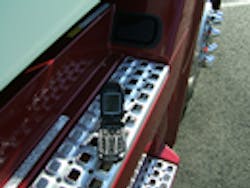A new study of 34,466 commercial vehicle operators monitored through in-cab video systems finds that only a small population of drivers – just 5% – are the most distracted behind the wheel and are the most likely to engage risky driving behavior. SmartDrive Systems, which conducted the study, said it evaluated more than 13.8 million video events recorded over the course of 2010, involving 34,466 commercial drivers, and quantified distractions such as cell phone usage, text messaging, use of maps or navigation, doing paperwork, and other actions.
The company found that 5% of drivers with the most driving distractions were distracted 67% of the time during which a risky driving maneuver was observed – nearly six times more often than the rest of the drivers, noted Jason Palmer, president of SmartDrive.
“Typically, we’re finding 5 to 10% of the commercial driver pool represents the bulk of the ‘distracted driving’ risk,” he told Fleet Owner. “They are the ones whose distracted behavior behind the wheel leads to the greatest amount of risky driving maneuvers and, eventually, to vehicle crashes.”
Overall, the distraction rate reached 9.7% of the time risky driving maneuvers were observed, according to SmartDrive’s 2010 study. The company noted that its metrics are compiled using in-vehicle recorders that capture video, audio and vehicle data during sudden stops, swerves, collisions and other risky driving maneuvers, then categorizes and scores events according to over 50 safety observations.
The nine most common distractions observed by the firm’s in-cab video system in conjunction with a risky driving maneuver were: object in hand (44.5%), talking on a handheld mobile phone (13.4%), drinking a beverage (12.7%), eating food (10.1%), smoking (9.9%), operating a handheld device (9.1%), talking/listening using a hands-free mobile device (5.2%), paperwork and map reading/navigation (1%), grooming/personal hygiene (0.6%).
SmartDrive noted two distractions in particular are riskier and more common among a small percentage the benchmark drivers – using a handheld mobile phone and operating a handheld device. In both instances, just 5% of the drivers accounted for the majority of events involving those devices – 57% of all mobile phone incidents captured and 52% of all operating handheld-device incidents.
Palmer also stressed that the risks of “distracted driving” can also be obscured by other metrics used to gauge the effectiveness of commercial vehicle operators.
“We recorded one driver whose texting and constant cell phone use while driving led to a high incident of hard braking and hard turning maneuvers – yet he also maintained the best on-time and delivery statistics within his fleet.” Palmer related.
“The important take-away from this report is that, throughout 2010, we continued to see a strong connection between these driving distractions and fundamental driving errors that can lead to collisions,” he noted. “Early identification of this 5% group is extremely important because the sooner they know who they are, the sooner fleets can begin training to change risky-driving behaviors in this higher-risk group.”About the Author
Sean Kilcarr
Editor in Chief
Sean Kilcarr is a former longtime FleetOwner senior editor who wrote for the publication from 2000 to 2018. He served as editor-in-chief from 2017 to 2018.
